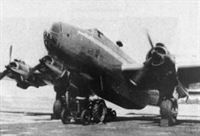Фотографии
-
Регистрационный номер: LN-OAS Halifax C.Mk 8 LN-OAS at Radlett in August 1947. This aircraft was sold to Vingtor Luftveier in Oslo, Norway, the same month, but was returned to Britain a year later, registered G-AJCG and operated by Bond Air Services Ltd. The registration was cancelled in September 1949 following clandestine disposal to Israel.
Самолёты на фотографии: Handley Page Halifax A/C / Halton - Великобритания - 1942
-
Регистрационный номер: G-AHDU Shortly after the Second World War, Short & Harland at Belfast converted a batch of 12 Halifax C.Mk 8s into ten-seat passenger transports for BOAC. Redesignated H.P.70 and named Halton I, the first aircraft, G-AHDU, ex PP310 and named Falkirk, flew on its proving flight to Cairo in August 1946, returning to Heathrow on August 8. This aircraft is seen on the ground. 'DU later passed to Aviation Traders and Bond Air Services Ltd, with whom it flew 363 return missions on the Berlin Airlift, and was finally scrapped at Southend in July 1950.
Самолёты на фотографии: Handley Page Halifax A/C / Halton - Великобритания - 1942
-
Самолёты на фотографии: Handley Page Halifax A/C / Halton - Великобритания - 1942
-
Регистрационный номер: TE580 The first prototype Hastings, TE580, made its initial flights from Wittering near Stamford because it was considered that the company's runway at Radlett was of insufficient length. The test flying was carried out by Sqn Ldr Maurice Hertford, on loan from the RAF. who temporarily replaced James R. Talbot, killed in the first flight of the Hermes I, G-AGSS, just outside Radlett's perimeter on December 2, 1945. In this photo TE580 is seen at Radlett in March 1948 fitted with a new tailplane having 10° anhedral. The aircraft had been returned to Radlett after a mishap at Boscombe Down. TE580 continued its contractor’s trials at Boscombe Down, and in April 1951 it was flown to Hatfield for use by the de Havilland Propeller Company Ltd until it was finally scrapped some years later.
Самолёты на фотографии: Handley Page Hastings / H.P.67 - Великобритания - 1946
-
Регистрационный номер: TG500 H. P. Hastings C.I TG500 was the second production aircraft, and first flew in May 1947. It was retained at Radlett on CS(A) charge for trial installations of modifications, and is seen with jeeps suspended for para-dropping tests in March 1948.
Самолёты на фотографии: Handley Page Hastings / H.P.67 - Великобритания - 1946
-
Регистрационный номер: TE583 In June 1949 Hastings TE583 was returned to Radlett after completing its temperate climate programme. It emerged from the hangars in October 1950, fitted with two early Metrovick Sa.2 in place of the outboard Hercules. Photo shows the Sapphire-Hastings at Radlett on October 25, 1950. After handling trials at Radlett (first flight May 30, 1950), TE583 was delivered to Farnborough for research by the National Gas Turbine Establishment. In 1953 the aircraft returned to Radlett and was fitted with a Victor crew door, subsequently being flown by the RAE to evaluate Victor crew escape procedures.
Самолёты на фотографии: Handley Page Hastings / H.P.67 - Великобритания - 1946
Статьи
- -
- E.K.W. C-35 /Preservation Profile/ (62)
- Miles Monitor /Press Debut/
- News Spotlight
- Personal album
- ??? - A veteran returns
- ??? - Carrier calamities
- A.Chapman, B.Olsen - Holscher's Heinkel
- B.Gunston - Lockheed's Leviathan
- B.Martin - Britain's civil aircraft register
- N.Parnell - Flut-R-Bug
- P.Birtles - T.K.2 /British pre-war ultralights/
- P.Heath - The Calshot ploughman
- R.Lindsay - De Havilland Venom, part 1 /Fighters of the fifties/ (19)





